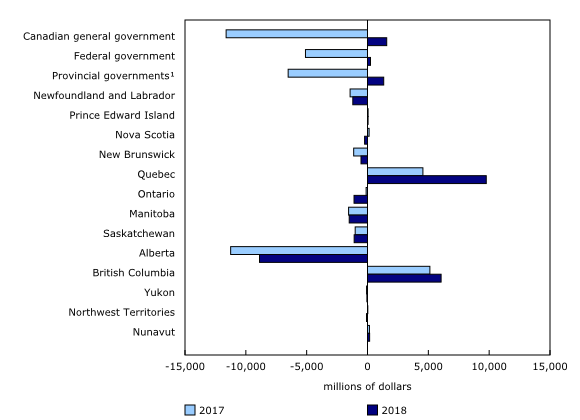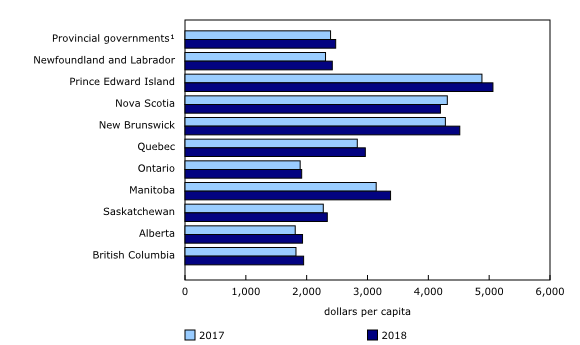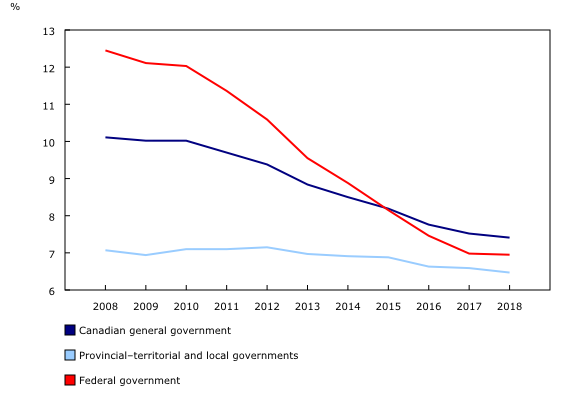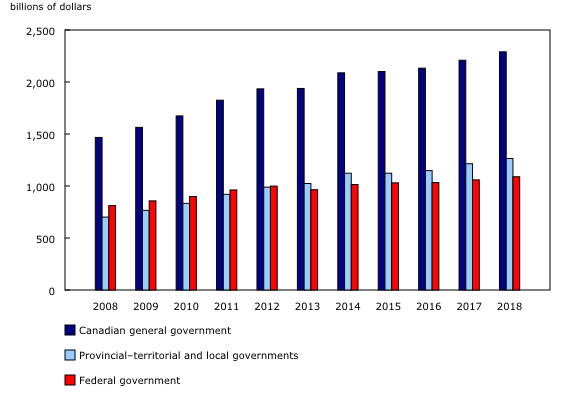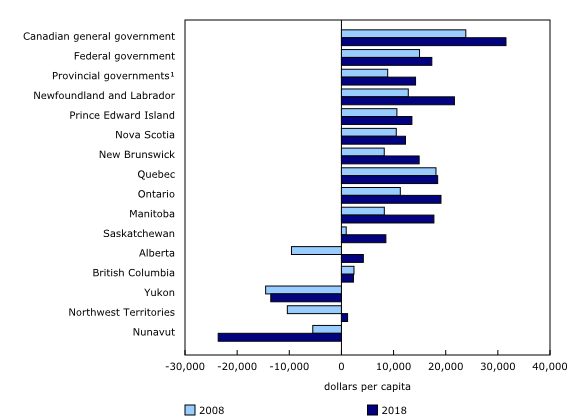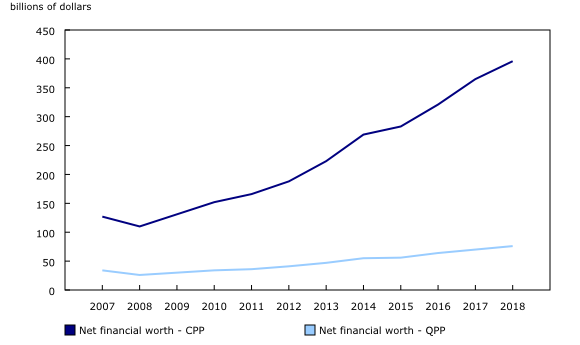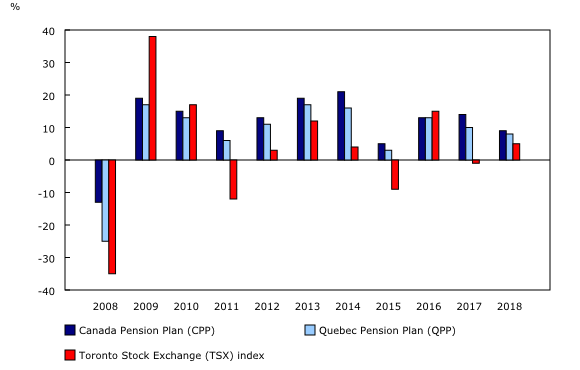Consolidated Canadian Government Finance Statistics, 2018
Archived Content
Information identified as archived is provided for reference, research or recordkeeping purposes. It is not subject to the Government of Canada Web Standards and has not been altered or updated since it was archived. Please "contact us" to request a format other than those available.
Released: 2019-11-20
First surplus in years for the Canadian general government
The consolidated Canadian general government (CGG)—federal, provincial–territorial and local governments combined—recorded a surplus of $1.6 billion in 2018, compared with a deficit of $11.6 billion in 2017. That surplus equalled 0.1% of the gross domestic product (GDP) in 2018.
The surplus is largely explained by economic growth, as GDP grew 3.9% in nominal terms and the increased economic activity generated an additional $36.2 billion in tax revenue.
The CGG surplus was mainly the result of a combined $1.3 billion surplus recorded in 2018 for the consolidated provincial–territorial and local governments (PTLG), compared with a $6.5 billion deficit the previous year. The remainder came from the federal government, posting a $0.2 billion surplus, up from the $5.1 billion deficit in 2017.
The net operating balance, also referred to as surplus or deficit, is calculated as revenues minus expenses over a given reference period and constitutes a summary measure of the sustainability of government operations.
In 2018, PTLG revenues (+5.3%) grew faster than expenses (+3.9%), reaching $589.0 billion. The increase in revenues was primarily driven by higher tax revenues (+$18.8 billion), grants from the federal government (+$4.4 billion) and sales of goods and services (+$3.9 billion).
For the federal government, revenues stood at $335.1 billion, up 6.7% from 2017. This increase was also driven by higher tax revenues, especially personal income taxes (+$11.1 billion). Expenses grew 4.9% to reach $334.9 billion.
The largest increases in expenses were recorded in grants to provincial–territorial and other government units (+$5.7 billion), followed by social assistance benefits (+$3.2 billion), such as old age security benefits, family allowances and child care benefits and compensation of federal employees (+$2.6 billion). On the other hand, employment insurance benefits paid decreased 4.8% to $16.7 billion, driven by a decline of 5.7% in the number of regular benefits beneficiaries and a slight decline (-0.1 percentage points) in the unemployment rate.
At the PTLG level, Nunavut (5.1%), Quebec (2.2%) and British Columbia (2.0%) recorded significant surpluses as a percentage of GDP in 2018.
The largest deficits as a percentage of GDP were in Newfoundland and Labrador (3.6%), Alberta (2.6%) and Manitoba (2.1%). New Brunswick recorded steady, large deficits over the past 10 years, but the deficit figure for 2018 (1.4%) was its smallest in the past decade.
Fiscal burden increases as government tax revenues grow faster than GDP
Consolidated revenues for CGG were $826.3 billion in 2018, up 6.0% from 2017. This growth was mainly the result of higher economic activity, with GDP up 3.9%. Taxes and social contributions accounted for 83.0% ($686.2 billion) of total revenues or 30.9% of GDP, up 0.6 percentage points compared with 2017. This amounted to $18,343 per capita in 2018.
Fiscal burden measures the taxes and social contributions (compulsory transfers), expressed as a percentage of GDP, paid to governments by individuals, businesses and non-residents. Personal income taxes and general sales taxes (such as GST and HST) paid by households accounted for 55.5% of all taxes and social contributions paid in Canada in 2018.
Fiscal burden grew 0.3 percentage points for both the federal government (14.1%) and for PTLG (16.9%). Among the provinces, the largest movements in 2018 were in Alberta (+0.9 percentage points), Saskatchewan (+0.7), British Columbia (+0.6), Prince Edward Island (-0.5) and Nova Scotia (-0.5). Quebec continues to have the highest fiscal burden at 22.0%, while the lowest remains in Alberta (11.1%).
The territories recorded a significantly lower fiscal burden than the provincial average, with Nunavut posting the lowest in 2018 at 4.9%. The territories rely heavily on federal transfers to deliver essential goods and services to the population. In 2018, taxes and social contributions accounted for 12.5% of total revenues in the territories, compared with 74.4% for transfers from the federal government. These transfers amounted to $50,044 per capita in Nunavut, $35,115 in the Northwest Territories and $28,595 in Yukon.
Prince Edward Island receives the highest grants revenue per capita among the provinces
The federal government extends different types of grants to provinces and territories to assist them in the provision of essential programs and services to all Canadians such as health care, education, social assistance and childhood development. The largest transfers are the Canada Health Transfer, the Canada Social Transfer, Equalization payments and Territorial Formula Financing.
In 2018, the provinces and territories received $92.7 billion in grants, a 5.0% increase from 2017. Receipts for both Quebec and Ontario accounted for 57.0% of PTLG grant revenue. On a per capita basis, federal grants received by PTLG stood at $2,477 in 2018 compared with $2,393 in 2017.
Among the provinces, Prince Edward Island received the highest grants per capita ($5,062) in 2018, followed by New Brunswick ($4,517) and Nova Scotia ($4,199). On the other hand, grants per capita to Ontario ($1,918) were the lowest in Canada, closely followed by Alberta ($1,932) and British Columbia ($1,950).
Interest expenses remain low despite steady increase in debt
In 2018, the CGG paid 7.4 cents in interest charges for every dollar of revenue received, down slightly from 7.5 cents in 2017. Interest expenses accrued on debt liabilities totalled $61.3 billion (or $1,638 per capita). Despite an increase of 56.1% in total liabilities ($2,290 billion in 2018) since the 2008 financial crisis, the ratio is significantly down from 10.1 cents in 2008 due to historically low interest rates on the outstanding debt.
The federal government paid 7.0 cents in interest for every dollar of revenue received in 2018, compared with 6.5 cents for PTLG. Quebec (9.9 cents), Manitoba (9.6 cents) and New Brunswick (7.1 cents) spent the most on interest per dollar of revenue in 2018.
Total liability remains above 100% of GDP
CGG's net liability (liabilities minus financial assets) increased by 3.0%, or $33.8 billion from 2017. Financial assets grew 4.4% to $1,110 billion ($29,665 per capita), while liabilities increased 3.7% to $2,290 billion ($61,221 per capita). CGG total liability to GDP ratio was stable at 103.0% (down 0.2 percentage points).
Net liability for the federal government rose by $19.2 billion in 2018, compared with a $14.6 billion increase for PTLG. Quebec was the only province to record a reduction (-$16.6 billion or -9.6%) of the net liability compared with 2017, driven by a $2.1 billion decline in liabilities and a $14.6 billion increase in financial assets. The largest increases in net liability were in Alberta (+157.7%), Saskatchewan (+14.4%) and Newfoundland and Labrador (+10.9%). In absolute terms, net liability grew $26.1 billion in Ontario (+$14.9 billion) and Alberta (+$11.2 billion) alone.
Newfoundland and Labrador recorded the highest PTLG net liability per capita ($21,667 or 34.1% of GDP), followed by Ontario ($19,092 or 32.3% of GDP) and Quebec ($18,460 or 35.5% of GDP). The year 2018 marks the first time Ontario recorded higher net liability per capita than Quebec.
Yukon and Nunavut were the only jurisdictions to post a positive net financial worth (financial assets minus liabilities) in 2018. Debt in the territories is low compared with the provinces since borrowing capacity is restricted to limits set by the federal government.
The federal government net liability to GDP ratio remained below the 30% level in 2018 at 29.2% (down 0.2 percentage points). This ratio is a key measure of the sustainability of fiscal policy. On a per capita basis, net liability increased 1.6% to $17,336. Debt securities ($776.5 billion) and federal employees' pension plans liabilities ($169.1 billion) represented 86.8% of total liabilities ($1,089.3 billion) in 2018.
CPP and QPP investments continue to grow strong
The Canada Pension Plan (CPP) and Quebec Pension Plan (QPP) are the largest social security funds in the country. Along with Old Age Security, they are the foundation of Canada's public retirement income system.
In 2018, Canadian workers and employers paid $66.7 billion (+5.7%) in contributions to CPP and QPP. In turn, beneficiaries received $61.2 billion (+4.5%) in pensions and benefits. For the year, the funds' net financial worth climbed 8.6% to $472.2 billion (+13.0% in 2017).
The CPP's and QPP's net financial worth measures the current assets (net financial assets) available for the payment of future social security benefits. At the end of 2018, net financial worth per capita was $12,622, up 7.1% from $11,781 in 2017. Since 2008, the CPP net financial worth posted growth of 260%, while the QPP recorded a 192% gain. For comparison, the Toronto Stock Exchange index grew 85% over the same period.
Sustainable Development Goals
On January 1, 2016, the world officially began implementation of the 2030 Agenda for Sustainable Development—the United Nations' transformative plan of action that addresses urgent global challenges over the next 15 years. The plan is based on 17 specific sustainable development goals.
The release "Consolidated Canadian Government Finance Statistics, 2018" is an example of how Statistics Canada supports the reporting on the Global Goals for Sustainable Development. This release will be used in helping to measure the following goal:

Note to readers
This release includes revisions to both unconsolidated and consolidated Canadian Government Finance Statistics (CGFS) data for the 2016 and 2017 reference periods as well as the addition of the 2018 reference period.
Annual data correspond to the end of the fiscal year closest to December 31. For example, data for the federal government fiscal year ending on March 31, 2019 (fiscal year 2018/2019), are reported for the 2018 reference year.
Preliminary CGFS data are published eight months after the end of the fiscal year, therefore estimates were prepared before several public accounts and financial statements were audited and published by government entities.
CGFS data differ from reports published by governments due to differences in institutional coverage, accounting rules, timing and integration with the Canadian macroeconomic accounts.
Consolidation is a method of presenting one overarching statistic for a set of units. It involves eliminating all transactions and debtor–creditor relationships among the units being consolidated. In other words, the transaction of one unit is paired with the same transaction as recorded for the second unit and both transactions are eliminated.
In 2018, the consolidation method removed $306.9 billion in internal revenues and expenses, as well as $256.9 billion related to internal debtor–creditor relationships for the CGG.
Consolidated data are released for the Canadian General Government (CGG), which combines federal government data with PTLG data but excludes data for the Canada Pension Plan and Quebec Pension Plan.
Consolidated data are also released for the provincial–territorial and local governments (PTLGs), which include provincial and territorial governments, health and social service institutions, universities and colleges, municipalities and other local public administrations, and school boards.
The constitutional framework of PTLGs in the territories differs from that in the provinces, leading to differences in the roles and financial authorities of government. These differences, as well as other geographic, demographic and socioeconomic dissimilarities between the North and the rest of Canada, give rise to marked disparities in government finance statistics.
PTLG data can be compared across provinces and territories because consolidation takes into account differences in administrative structure and government service delivery by removing the effects of internal public sector transactions within each jurisdiction.
Because PTLG finance statistics vary significantly across jurisdictions in Canada due to size differences, per capita data are used to facilitate comparisons. Per capita data are based on population estimates as of April 1st for Canada, the provinces and the territories, available in Table 17-10-0009-01.
Calculations as a percentage of GDP are based on GDP at current market prices, expenditure-based, estimates for Canada, the provinces and the territories, available in Table 36-10-0222-01.
Unemployment rate, monthly, seasonally unadjusted available in Table 14-10-0287-01. Employment insurance beneficiaries who receive regular income benefits, monthly and unadjusted for seasonality, available in Table 14-10-0010-01. Growth rates are calculated from a March to March period to match the federal government end of fiscal year (March 31st).
In this release, revenues, expenses, assets and liabilities are reported in nominal terms.
Net financial worth is defined as the total value of financial assets minus the total value of outstanding liabilities. When financial assets are greater than liabilities the measure is referred to as net financial assets. When liabilities are greater than financial assets the measure is referred to as net liabilities or net debt as per public accounts.
Products
The Canadian Government Finance Statistics 2014 classification structure is now available in the Definitions, data sources and methods module of our website.
Additional information can be found in the Latest Developments in the Canadian Economic Accounts (13-605-X). The User Guide: Canadian System of Macroeconomic Accounts (13-606-G) is also available. This publication has been updated with Chapter 9. Government sector accounts in the Canadian System of Macroeconomic Accounts.
Contact information
For more information, or to enquire about the concepts, methods or data quality of this release, contact us (toll-free 1-800-263-1136; 514-283-8300; STATCAN.infostats-infostats.STATCAN@canada.ca) or Media Relations (613-951-4636; STATCAN.mediahotline-ligneinfomedias.STATCAN@canada.ca).
- Date modified:


